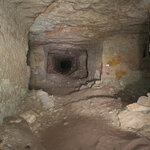Archaeology

It's no secret that war is tough on innocent buildings so it is no surprise that four of six major archaeological sites in Syria have been heavily looted and damaged, according to an analysis of high-resolution satellite images.
The report analyzes 6 of the 12 sites that Syria has nominated as World Heritage Sites: Dura Europos, Ebla, Hama's Waterwheels, Mari, Raqqa, and Ugarit. Images from 2014 show numerous pits throughout three sites where ancient cities once stood. The pits generally do not appear in similar images from 2011, when the conflict in Syria began.
"This report…

The "Basel-Gasfabrik" Celtic settlement, at the present day site of Novartis, was inhabited around 100 B.C. and is one of the most significant Celtic sites in Central Europe.
A team recently examined samples from the backfill of 2000 year-old storage and cellar pits from the Iron Age and found the durable eggs of intestinal parasites like roundworms (Ascaris sp.), whipworms, (Trichuris sp.) and liver flukes (Fasciola sp.).
The presence of the parasite eggs was not established by wet sieving of the soil samples, instead they applied a geoarchaeology-based method using…

The oldest recorded stone tool found to-date has been unearthed in Turkey.
The chance find of a humanly-worked quartzite flake, in ancient deposits of the river Gediz in western Turkey, show that humans passed through the gateway from Asia to Europe much earlier than previously thought, approximately 1.2 million years ago and provides new insight into when and how early humans dispersed out of Africa and Asia.
The international team used high-precision equipment to date the deposits of the ancient river meander, giving the first accurate time-frame for when humans occupied the area.
Credit:…

Though humans did not exist 400,000 years ago, human ancestors did - and they left behind engravings on a fossilized shell from Java, establishing a new benchmark for the earliest known example of ancient humans deliberately creating pattern.
The newly discovered engravings resemble the previously oldest-known engravings, which are associated with either Neanderthals or modern humans from around 100,000 years ago. The zig-zag pattern engravings were only recently discovered on the fossilized mussel shells, which had been collected 100 years ago. There is no way to know if the…

There are not a lot of new stories to be found by the humanities in ancient parchments, but millions of documents stored in archives could trace agricultural development across the centuries, thanks to increasingly progressive genetic sequencing techniques.
Thanks to sequencing, vital information can be derived from the DNA of the parchment on which they are written.
Researchers extracted ancient DNA and protein from tiny samples of parchment from documents from the late 17th and late 18th centuries. The resulting information enabled them to establish the type of animals from which the…

Even while the Roman empire was in decline, precious substances, such as frankincense, were being transported to its furthest northern outpost in Britain.
Archaeologists writing in the Journal of Archaeological Science used molecular analysis of materials previously thought to be of little interest, debris inside burial containers and residues on skeletal remains and plaster body casings, to show that frankincense were being used even in the farthest corners of the Empire. Evidence for the use of resins in ancient funerary rites is uncommon outside of Egypt.
The samples came…

Empires have risen and fallen and often it has been due to changes in the climate. When agriculture was a more demanding endeavor people wanted the most fertile lands and as that shifted, so did cities.
For that reason, climate change has often been cited as the most logical reason for a huge population collapse in Europe at the end of the Bronze Age. Now archaeologists and environmentalists say they can prove definitively that climate change could not have been the culprit. Because the changes in climate that scientists believed to coincide with the fall in population in fact occurred…

The remains of two Ice Age infants are the youngest human remains ever found in northern North America, according to a new paper.
The remains of the infants date to around 11,000 years ago and were found in 2013 at an excavation of the Upward Sun River site, near the Tanana River in central Alaska.
Ben Potter of the University of Alaska Fairbanks, the paper's lead author, and colleagues say that the human remains and associated burial offerings, as well as inferences about the time of year the children died and were buried, could lead to new thinking about how early societies were…

Underneath the ancient royal buried ground of Saqqara in the Egyptian desert lies something even creepier than mummies that might come back to life - mummies that might come back to life and be adorable.
The Sacred Animal Necropolis, as it was called after being discovered by archaeologists last century, was dedicated to Anubis - that is the one with the head of a dog/jackal - and is believed to contain up to 8 million animals, most of them small dogs. It's hard to be sure because the animals were not mummified the way royal members were so they have just basically decomposed into heaps of…

The social sciences have simultaneously become increasingly specialized and over-lapping. A new field calls itself Continental Shelf Prehistoric Research and it studies the remains of prehistoric human settlements which are now submerged beneath coastal waters.
Some of the now-drowned sites are tens of thousands of years old, requiring archaeologists to get help from oceanography and the geosciences. A recent paper describes how during the successive ice ages of the last million years, the sea level dropped at times by up to 120 meters and the exposed area of the continental shelf added…